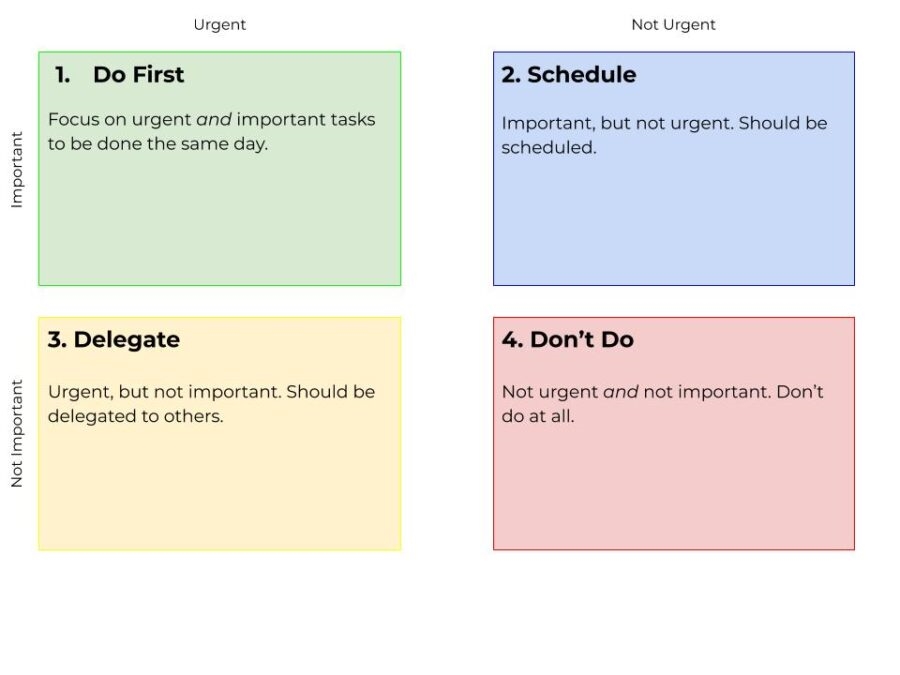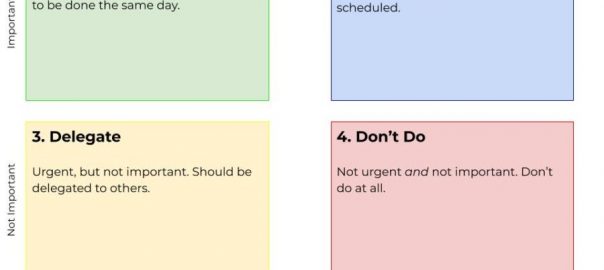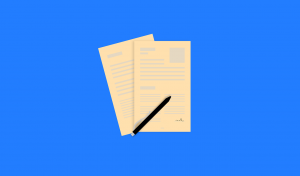As an entrepreneur, how often do you complete everything on your to-do list? Do you ever feel like there is too much to do in too little time? If so, you’re in the right place. I’m going to share with you, the entrepreneur, four easy productivity tips to decrease the size of your to-do list and increase your focus on the remaining critical tasks.
Having worked with brilliant and motivated people in my day job as Head of News & Media at InfoTrust, a digital analytics consultancy, I have seen the struggles of high performers. It generally comes back to too much to do, too little time.
Do, Decide, Delegate, or Delete
President Dwight D. Eisenhower, a five-star general during WWII and the 34th president of the United States knew a bit about productivity. He led one of the most productive administrations during his two terms as president, creating NASA, the Interstate Highway System, adding Alaska and Hawaii to the US, and signing the first significant civil rights legislation since the end of the Cold War.
Stephen Covey, author of one of the best-selling books of all time, The 7 Habits of Highly Successful People, introduced a simple tool to prioritize tasks based on Eisenhower’s insights called the Eisenhower Matrix.

This framework helps people organize and prioritize tasks to eliminate time-wasters and create more mental space for focusing on important tasks.
For entrepreneurs, you’re in a similar position as Eisenhower, whether you recognize it or not. You are the president of your business. Often, you’re also the only employee (shout out to the solopreneurs!). How can you use the Eisenhower Matrix to improve productivity?
Without diving headfirst into the Eisenhower Matrix (there’s much specific content online), the Eisenhower Matrix will give you a framework for focusing on the urgent and essential tasks in your business. Your focus should be on Important tasks. While this focus seems obvious, many high performing people can quickly lose track of prioritization.
In his book, Covey breaks down the Important tasks into two quadrants:
- Quadrant 1: Urgent and Important (Do)
- Quadrant 2: Not Urgent and Important (Schedule)
The other half of the Eisenhower Matrix is then broken down into the Not Important tasks, as work to Delegate or Delete:
- Quadrant 3: Urgent and Not Important (Delegate)
- Quadrant 4: Not Urgent and Not Important (Delete)
Let’s go through some examples.
Example 1: Respond to customer complaints about your online product or service
Customer service is always vital to your business. Let me first stress that. Without the customer, you don’t make any money. However, all customer complaints aren’t equal.
However, there is a difference between tasks that are “important for your business” and “important for YOU to do.” Meaning, it’s important for your business to respond to the complaint, but it’s not important for YOU (the owner, CEO) to respond to the complaint.
Using the Eisenhower Matrix, we know we’re on the left side of the matrix because complaints are generally urgent. But, who should handle the complaint? As the owner, if you have no other employees or contractors, that’s a task for you to DO. You don’t want to ignore it or delay a response because that will negatively impact your business.
But, if you have employees (or can hire contractors), you don’t have to be the person responding to each customer service complaint. You can DELEGATE that work.
Example 2: Create 2020 Business Objectives and KPIs
This one should be fairly obvious, but when it comes to planning and goals, that’s your responsibility. You shouldn’t ask someone else to come up with objectives and KPIs for YOUR business.
Depending on what time of the year it is (are we close to the new year or not?), this task is undoubtedly important but might not be urgent. Based on timing, this task would fall into either Quadrant 1 (Do) or Quadrant 2 (Schedule).
If it’s December and you’re trying to plan for the next year, I’d argue it’s a bit more Urgent than if it’s October.
Time Block Your Calendar
Once you’ve gone through and prioritized your tasks using a framework like the Eisenhower Matrix, I would highly suggest that you time block your calendar to schedule the tasks you need to complete.
Time blocking means going into your calendar and blocking time off (or scheduling time) to handle the tasks in your queue. It allows you to have a clear indication of what you should be working on and when.
I do my creative work, like writing for blogs and guest posts or creating online courses, in the early morning before my day job and on the weekends. I’ve learned that’s when I’m the most creative and motivated. It’s much easier for me, and I can get more accomplished.
For the back of the house tasks, like accounting or blogger outreach, I do that work at night because it doesn’t take much brainpower or creativity to complete. You can see an example of how I time block my calendar here.
You’ll need to figure out what works best for you, and then you can time block your calendar to ensure you’re productive.
The only thing to keep in mind with this strategy is that it’s vital you honor your calendar. There isn’t a productivity system or prioritization framework in the world that can make you focus on the tasks at hand. Doing the work is on you and requires discipline.
Focus On One Task at a Time
Multitasking is the single greatest threat to your productivity as an entrepreneur. Read that again. It’s that important.
Let’s review some statistics on multitasking and productivity:
- Multitasking decreases productivity by as much as 40% and drops IQ by 10% (HBR article link).
- Completing tasks when multitasking takes 50% longer and causes 50% more errors (John Medina, Brain Rules).
- We even are tricked into believing we can multitask effectively. Even though we think we’re multitasking productively, our brains are just switching rapidly between unrelated tasks (Scientific American podcast).
- “In a recent study, a group of Microsoft workers took, on average, 15 minutes to return to serious mental tasks, like writing reports or computer code, after responding to incoming e-mail or instant messages. They strayed off to reply to other messages or browse news, sports or entertainment Web sites.” (NY Times)
Hopefully, it’s now clear how important it is to focus on one task at a time. As an entrepreneur, there are many, many different kinds of jobs you need to do. Accounting, finance, marketing, customer service. The list goes on.
Unfortunately, there is no way around wearing those many hats in your business. But, you can choose to focus on individual tasks to ensure they’re done correctly and on time.
To focus on the task at hand, this means cutting out distractions like the TV, social media, and surfing the internet. I’ll discuss strategies in the next section to optimize your workspace to minimize distractions.
Optimize Your Workspace
Optimizing your workspace means ensuring it is free from distractions with a singular focus on maintaining your productivity. It can be achieved in many different ways, and you’ll need to figure out what works for you, but I’ll give you an idea of how I optimize my workspace to be productive.
I’ve already mentioned I optimize the time I write (early morning), but I also optimize where I write. I have an office in my home that has a big L-shaped desk where my laptop and external monitor reside. I also have a large flatscreen TV hanging on the wall my desk faces with (almost) every major streaming app. Watching TV and trying to multitask is one of the biggest challenges I face.
When I write, I turn off my TV. I disconnect my external monitor from my laptop so that I only have one monitor in front of me. I do all of my writing in one laptop window in the Grammarly desktop app and minimize all other windows. I put my iPhone/Apple Watch on Do Not Disturb mode. I also turn on a Spotify playlist called “Reading Chill Out” and listen with noise-canceling headphones at about 25% volume.
By reducing distractions in my workspace, I’ve dramatically improved my productivity. Especially for creative and thinking-intensive tasks like writing and course creation.
If you want to be more productive, review your workspace for distractions. By reducing these distractions, you’ll be smarter, more focused, and more productive. And that’s what we call a “Win-Win.”
Hopefully, this post has given you four useful tips to use to increase your productivity.
The Eisenhower Matrix is great for prioritizing and minimizing your task list so that you can focus on the most critical areas for your business.
Once you have those tasks identified, time blocking your calendar will ensure you schedule time to complete the tasks. Time blocking will also help to remind you to focus on just that task so that you’re not multitasking.
And when its time to focus on that single task, make sure you optimize your workspace to remove distractions. A distraction-free workspace is a productive workspace.
Business & Finance Articles on Business 2 Community
(20)






